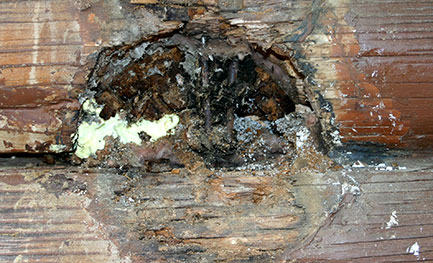Life is full of surprises, and not all of them good! Depending on the severity of the incident, picking up the pieces and putting things back as they were can be a challenge many homeowners would rather avoid. The "big three" that can damage a home environment are: Water, Fire, and Mold. Each have their own set of health and safety risks, requiring specialized clean-up and restoration techniques. [Note: Ad or content links featured on this page are not necessarily affiliated with IICRC (The cleantrust) and should not be considered a recommendation or endorsement by IICRC (The cleantrust)].
Water Damage
Not all types of water damage require the same restoration efforts. Knowing the water's origin is a good way to ascertain the health threat.
- Clean water - from a leaky roof or broken water pipe. Usually not directly harmful to your health.
- Dirty water - comes from dishwashers, washing machines, or overflowing toilets. Saturated areas may require antimicrobial treatment to fully eliminate health risks.
- Severely Contaminated - comes from flooding or sewer line breakage. Is often extremely dangerous to health!

Without proper clean-up and restoration, any level of water damage can lead to more serious problems including loss of personal belongings, mold growth, and structural damage. Who can a homeowner turn for some peace of mind? The Institute of Inspection, Cleaning and Restoration Certification (IICRC). They can help locate a certified professional that is trained to clean-up and restore water damaged areas.
Fire Damage
It doesn't take long for fire to destroy. Damage can vary, being relatively minor like a scorched wall, to the most severe of consuming the entire house. However, even areas that are not touched by fire can still be affected by smoke and soot damage. If left untreated, both can lead to health problems. Depending on the areas and severity of damage, clean-up and restoration may require a number of actions. They may include:
- Wall/Structural repair or replacement
- Soot removal
- Smoke odor removal requiring carpet and upholstery cleaning and deodorizing.
The goal of a cleantrust-certified firm is to restore a home and its contents to their original (pre-fire) state.
Mold Damage
What is mold and why is it dangerous to humans? Mold is actually a fungus. It is a common component of household and workplace air and dust. However, when mold spores are present in large quantities, they can present health hazards, potentially causing respiratory problems and allergic reactions. Where is mold found? Mold in the home can usually be found in damp, dark, or moisture-filled areas like bathrooms, basements, crawl spaces, attics, plumbing areas, and areas with poor ventilation. If flooding has occurred, mold can grow in unseen areas like inside walls or in sub-flooring. Some of the symptoms caused by mold are: watery itchy eyes, a chronic cough, headaches, difficulty breathing, rashes, tiredness, sinus problems, nasal blockage and frequent sneezing. Due to the potential health risks and the places mold can hide, to ensure a safe and healthy environment, it is important to use the proper clean-up and restoration techniques - techniques that cleantrust-certified firms can implement to counteract mold damage.
Conclusion
Dealing with water, fire, or mold damage is not a "surprise" most homeowners want to experience. Removing the problem can be time consuming and difficult. The IICRC recognizes the difficulty and dangers that such damages present. They recommend using a certified professional to reverse the damage, clean-up and remove any health hazards, and restore your living area to a safe and healthy state.









